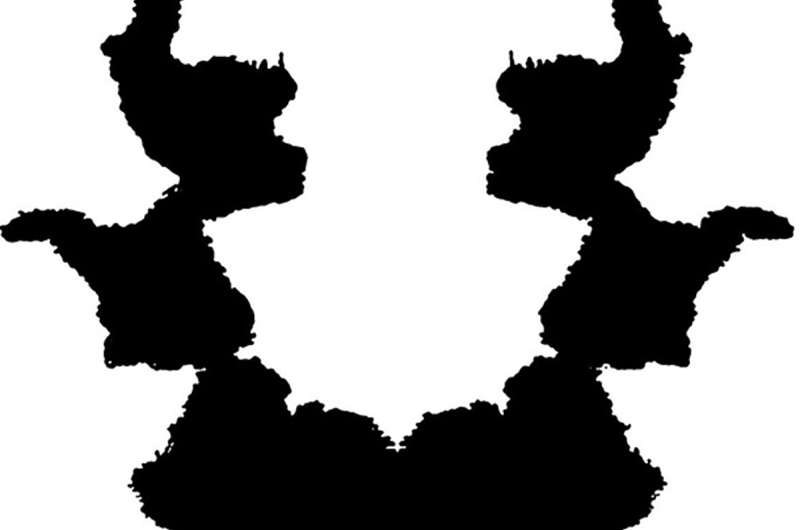Fractal edges shown to be key to imagery seen in Rorschach inkblots

Researchers have unlocked the mystery of why people have seen so many different images in Rorschach inkblots.
The image associations—a bat, woman with a ponytail, many different animals, people, a jack-o-lantern and more—are induced by fractal characteristics at the edges of the blots and depend on the scaling parameters of the patterns, according to a nine-member team led by University of Oregon physicist Richard P. Taylor in a paper published in the journal PLOS ONE.
Fractals are objects with irregular curves or shapes and are recognizable building blocks of nature. Trees, clouds, rivers, galaxies, lungs and neurons are fractals.
The new discovery isn't about improving inkblots for psychological assessments—their use became controversial and mostly set aside in the last 20 years. It does, however, have implications for Taylor's efforts to design a fractal based retinal implant and for potentially improving materials used for camouflage.
"These optical illusions seen in inkblots and sometimes in art are important for understanding the human visual system," said Taylor, who is director of the UO Materials Science Institute. "You learn important things from when our eyes get fooled. Fractal patterns in the inkblots are confusing the visual system. Why do you detect a bat or a butterfly when they were never there?"
Hermann Rorschach, a Swiss Freudian psychiatrist, published 10 inkblot patterns on separate cards, five done in black and white and five in color, in 1921. To make them, he poured different amounts and kinds of ink onto cards, folded them and pressed them tightly before opening them to display symmetrical patterns of varying complexities.
Rorschach died in 1922 and never knew about the subsequent widespread use of the inkblots to help assess a person's personality and mental health. Up to 300 differently perceived images have been recorded for each of the 10 inkblots. Whether such perceptions speak to mental health, reflect a person's level of creativity or simply draw from a person's past experiences has been debatable.
It is the complexity of the inkblots that Taylor's team, which included collaborators from five institutions, has dissected.
The group analyzed the boundaries of the inkblots. The work involved scanning them and then extracting the boundaries between regions of ink absorption and unstained portions of the cards using an edge-detection computer analysis. That analysis quantified the visual complexity of the blot boundaries using a parameter called fractal dimension D.
Combining these pattern analysis results with original psychology studies conducted on the blots in the 1930s and 1950s, the researchers uncorked "a very clear trend" between the dimensional values of the cards and their ability to induce images, Taylor said.
"As you increase the D value, which makes for more visual complexity, the number of visual perceptions fall off," he said. "People see a lot more patterns in the simple ones." Inkblots with D values of 1.1 generate the highest numbers of perceived images, the team found.
The team then put their findings to a human test, generating computerized fractal patterns with varying D values. When seen for 10 seconds by psychology undergraduate psychology students at the University of New South Wales in Australia, the same trend between D values and imagery surfaced.
Fractal patterns are also found in the artwork of Jackson Pollock, whose abstract expressionist paintings captured Taylor's lifelong interest in childhood. Pollock's paintings from 1943 to 1952, Taylor has found, are composed of fractals with D values that increased from 1.1 to 1.7. That change was deliberate, Taylor said, as Pollock sought ways to reduce imagery figures seen in his earlier work.
The study is among many that Taylor and his colleagues have pursued to better understand the connection between vision and nature. In 2015, Taylor and the UO along with Simon Brown and the University of Canterbury in New Zealand obtained a U.S. patent for using artificial fractal-based implants to restore sight to the blind. The patent covers all fractal designed electronic implants that link signaling activity with nerves for any purpose in animal and human biology.
In January 2016, Taylor received a $900,000 grant from the W.M. Keck Foundation to pursue his work on fractal-based implants.
"All of our studies are highlighting an effect called fractal fluency," Taylor said. "The eye has evolved to efficiently process the fractal patterns found in nature's scenery. This reduces the observer's stress by up to 60 percent. If you don't build fractal fluency into a bionic eye, not only have you lost the ability to navigate, you've also lost that symbiotic relationship with nature's fractal patterns."
More information: PLOS ONE, DOI: 10.1371/journal.pone.0171289
Journal information: PLoS ONE
Provided by University of Oregon



















